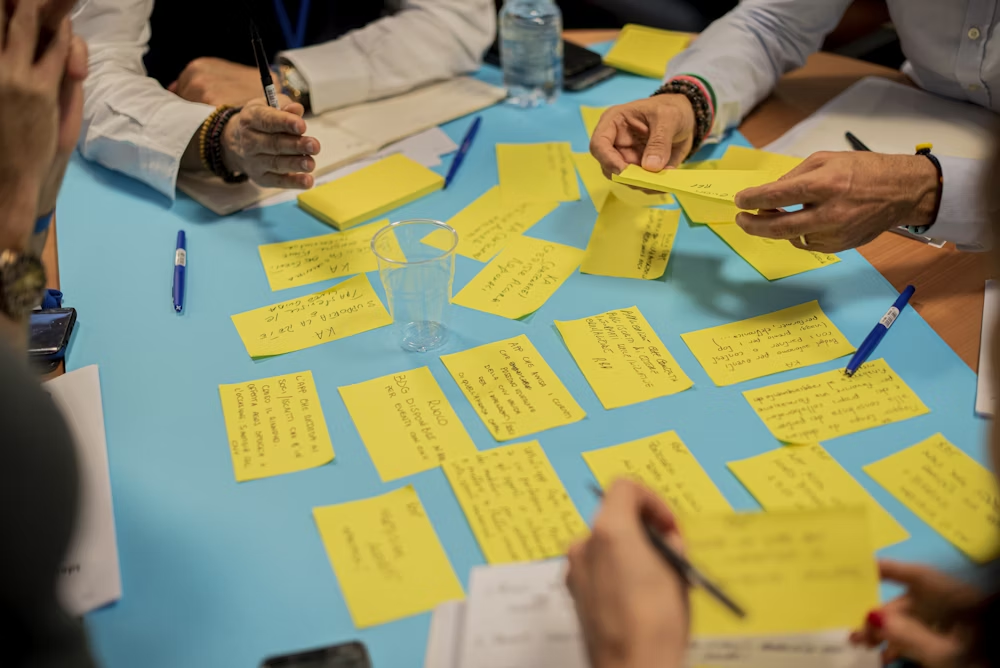Concept Mapping for Research Projects
- Introduction
- What is concept mapping in research?
- What is the purpose of concept mapping?
- Examples of concept maps
- How are concept maps used in research?
- Benefits of a concept map
- What is the concept mapping process?
Introduction
Concept mapping is a straightforward yet powerful technique that offers a bird's eye view of scientific knowledge and connections between ideas. Through concept mapping, research can be systematically arranged to allow researchers to analyze complex topics, making it easier to see how different concepts relate to one another.
It transforms abstract thoughts into a clear, visual representation of scientific knowledge, acting as a practical tool for bridging brainstorming and detailed data analysis. Concept mapping is especially beneficial for uncovering relationships between concepts that may not be immediately obvious.
This article outlines what the concept mapping process entails, its purposes, and its advantages. It also provides a step-by-step guide on creating concept maps for your research project, supplemented with examples.

What is concept mapping in research?
Concept mapping for qualitative studies is a valuable tool that allows researchers to visualize the relationships between different ideas, concepts, or pieces of information. It involves creating a diagram that showcases how various elements are interconnected, often revealing patterns, hierarchies, and associations that might not be evident through text alone. The map starts with a central idea or question and branches out to show how subsidiary ideas connect to it and to each other.
This technique is grounded in the cognitive sciences, reflecting how the brain organizes and structures knowledge. By mapping out concepts, researchers can more easily comprehend the scope of a project, identify gaps in knowledge, and determine the direction of their inquiry. It serves not just as a method for organizing thoughts but also as a tool for critical thinking and analysis.
In the context of research, concept mapping can be used at various stages of a project. Initially, it can help in formulating a research question or questions by visually exploring the key themes and variables involved. Throughout the research process, concept maps can be adapted and expanded to incorporate new findings and insights, making them dynamic tools for understanding and communication.
Moreover, concept mapping fosters collaboration among research team members, providing a shared visual language that can bridge disciplinary divides. It can visually present complex ideas, making discussions more productive and helping to align the team’s understanding and approach.

What is the purpose of concept mapping?
A concept map shows scientific knowledge in an organized manner. Moreover, it serves as a multifaceted tool designed to enhance comprehension, communication, and collaboration in research. At its core, concept mapping aims to clarify complex ideas and relationships, making abstract concepts more accessible and understandable. This clarity is achieved by visually representing ideas, which helps researchers and stakeholders alike grasp the breadth and depth of a project more intuitively.
One primary objective of concept mapping is to foster critical thinking and analytical skills regarding a particular research topic. By visually laying out the connections between concepts, researchers are encouraged to explore and question the nature of these relationships, potentially uncovering new insights or identifying underlying assumptions. This process promotes a more thorough examination of the subject matter, encouraging a deeper engagement with the material.
Furthermore, using concept maps can aid in the identification of gaps in knowledge. By organizing concepts visually, it becomes easier to spot areas that are underexplored or lacking in evidence. This can guide future research directions, ensuring that efforts are focused on filling these gaps and advancing understanding of the topic.
Another significant purpose of concept mapping is to enhance collaboration among researchers. By providing a clear and shared visual representation of a project’s structure, concept maps facilitate communication among team members, regardless of their disciplinary backgrounds. This shared understanding helps to align research efforts, streamline decision-making processes, and encourage collaborative problem-solving.

Examples of concept maps
Concept maps are versatile tools that can be applied across diverse research areas to clarify complex ideas and foster deeper understanding. Below are conceptual examples from different domains, showcasing how concept maps can be tailored to specific research needs.
Environmental science
Imagine a study that employs mind mapping to focus on the impacts of climate change on coastal ecosystems. Researchers could use concept mapping to illustrate the intricate relationships between species, habitats, and environmental stressors. The map might center on "Coastal Ecosystems," branching out to related concepts like "Sea Level Rise," "Salinity Changes," and "Species Migration." This visual representation could help in understanding the multifaceted effects of climate change, guiding conservation efforts and policy development.
Education
In exploring factors that influence student motivation, educational researchers might create a concept map to visualize connections between the classroom environment, teaching methods, and student engagement. Key elements such as "Active Learning," "Feedback," and "Classroom Climate" could be linked to impact "Student Motivation." This concept map could serve as a foundation for strategies to boost engagement and learning outcomes, demonstrating concept mapping's applicability in educational interventions.
Health sciences
For a study on Alzheimer's disease progression, a concept map could delineate complex pathways leading to neuronal degeneration. Featuring "Alzheimer's Disease" at its center, branches could extend to "Genetic Factors," "Environmental Influences," and "Biochemical Processes." This approach might identify potential therapeutic targets and help address health challenges.
Technology and business
Researching how small businesses adopt new technologies could involve a concept map exploring decision-making factors. The central theme "Technology Adoption" might connect to "Cost-Benefit Analysis," "Organizational Culture," "Market Trends," and "Regulatory Environment." This method could capture the multifaceted nature of technology adoption decisions, aiding in the development of supportive strategies for small businesses.
How are concept maps used in research?
Concept maps are utilized in research to facilitate a range of critical activities, from the initial stages of project planning to the dissemination of research findings. Their use enhances the clarity, organization, and effectiveness of research efforts in several key ways.
At the outset of a research project, a concept map can help in defining the scope and objectives. Researchers can use a concept map to identify and visually represent the main themes and questions their project will address. This early visualization aids in pinpointing the focus areas and can highlight potential research questions or hypotheses that warrant further exploration.
Throughout the research process, concept maps serve as dynamic tools for organizing and synthesizing information. As new data is collected and analyzed, the concept map can be updated to reflect new insights, connections between concepts, and emerging patterns. This ongoing adjustment helps researchers maintain a clear overview of their project, ensuring that their data analysis remains structured and focused.
Concept maps also play a role in identifying relationships between variables and in revealing gaps in existing knowledge. By laying out the known connections and highlighting areas with limited information, researchers can more easily identify where further investigation is needed, guiding the direction of subsequent research efforts.
In terms of collaboration and communication, concept maps are invaluable. They provide a visual language that can be shared among team members and stakeholders, facilitating discussions and ensuring that all parties have a common understanding of the project’s framework and findings.
Finally, when presenting research outcomes, concept maps can effectively summarize and convey complex information to diverse audiences. They can be used in reports, presentations, and publications to illustrate the study’s structure, findings, and implications clearly and concisely, making the research accessible to both academic and non-academic audiences.

Benefits of a concept map
Concept maps offer a range of benefits that enhance the research process, making complex information more manageable and comprehensible. These benefits can be broadly categorized into improving understanding, facilitating communication, and aiding in the planning and organization of research.
Enhancing understanding
Concept maps help distill complex ideas into visual formats, making abstract concepts more tangible. By laying out the relationships between different pieces of information, these maps enable researchers to see patterns and connections that might not be obvious in textual form. A concept map can lead to a deeper understanding of the subject matter, as it encourages the identification of relationships, hierarchies, and networks within the research topic.
Facilitating communication
One of the key advantages of concept maps is their ability to act as a communication tool among research team members and with external stakeholders. They provide a shared visual language that can help in explaining ideas clearly and succinctly, bridging knowledge gaps between individuals with different expertise or backgrounds. This common ground is especially valuable in multidisciplinary research teams, where understanding each others' perspectives contributes to collaborative success. Moreover, concept maps can be effective in presentations or publications by conveying findings and theories in a more engaging and understandable way.
Aiding planning and organization
In the context of research planning and organization, concept maps serve as an invaluable tool for structuring projects and outlining research strategies. They allow researchers to visually map out the scope of their study, identify key components and variables, and organize their approach to data collection and analysis. This can support a more efficient use of resources and time, as potential overlaps or gaps in research can be identified early in the process. Furthermore, concept maps can be used to track progress over time, providing a clear overview of how individual pieces of research contribute to the overall project goals.

What is the concept mapping process?
The process of creating a concept map involves several structured steps that guide researchers from the initial exploration of a topic to the development of a comprehensive visual display of their ideas and findings. This process can be divided into key phases: starting with a literature review, drafting an initial mind map, and refining the concept map into a final version.
Conducting a literature review
The first step to creating a concept map is to conduct a thorough literature review. At this stage, the researcher gathers existing knowledge on the topic, identifying key concepts, theories, and relationships that have been previously established. The literature review helps in framing the main idea or question that will be at the center of the concept map. It provides a solid foundation of information from which researchers can begin to build their map, ensuring that it is grounded in established research and theory.
Drafting an initial map
With a clear understanding of the topic from the literature review, the next step is to start drafting an initial concept map. This can begin as a simple mind map, with the main idea at the center and primary concepts branching out from it. Researchers can then add layers of detail, linking related concepts and indicating the nature of their relationships. This initial draft is a flexible tool, allowing for easy adjustments as new ideas emerge or as the structure of the map evolves.
Refining the concept map
The last phase involves refining the initial draft into a final version of the concept map. This step may require multiple revisions, as researchers review their concept map for clarity, coherence, and completeness. It's an opportunity to ensure that all relevant concepts are included and accurately represented. The final version should clearly convey the main idea, its supporting concepts, and their interconnections. This polished concept map can then be used for various purposes, such as the basis for a research project, a visual aid in a blog post, or a tool for communication within a research team.




